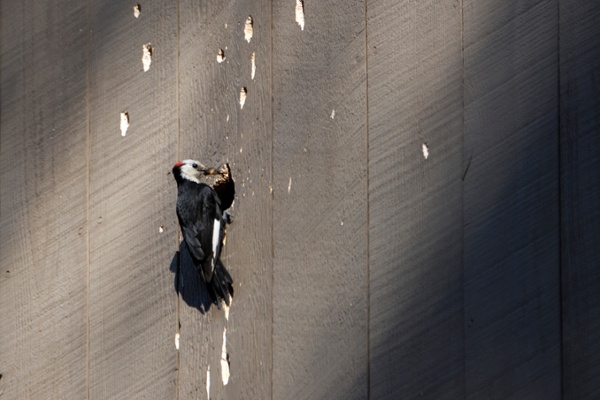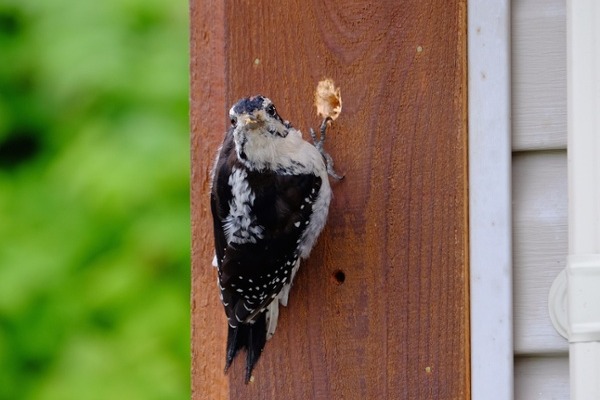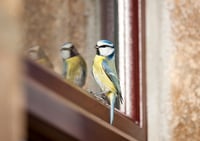
Woodpecker damage can affect any wooden building. While looking for food, the birds will peck holes in wooden beams, posts, and siding. They may decide that your bedroom wall is the perfect place to engage in "drumming," a social behavior that does little damage but is quite annoying if you are trying to sleep.
Even worse, they are hole nesters and can do significant damage if they decide that your building is a better place to set up home than a nearby tree. Because woodpeckers are protected, you need to convince them to go somewhere else without harming them. In addition to wood, woodpeckers will sometimes damage stucco, Dryvit, and other modern building materials. They can damage plumbing and electrical lines inside the wall and allow moisture into the structure.
Woodpeckers can even damage or injure ornamental and shade trees. Native trees have evolved to handle woodpecker behavior, but non-native trees used in your landscaping may be more vulnerable.
So, how can you keep woodpeckers off your building and prevent woodpecker damage? Try these nine strategies:
1. Install Netting
The most effective and permanent way to deter woodpeckers is to use fine mesh netting, such as StealthNet, over your building’s siding. Bird netting is often the right solution for commercial properties and large buildings, but homeowners tend to find it visually less appealing than other options.
Placing nets over just the areas the woodpeckers are targeting can be effective. One suggestion is to hang nets from the eaves. You can leave the hooks up year-round but put the net up only when the woodpeckers are around.
2. Hang Aluminum Flashing
Woodpeckers don't like shiny objects. Covering their holes with aluminum flashing as soon as possible will deter them from returning to that area. This won't stop drumming (in fact, some woodpeckers love to drum on metal, as it's more resonant), but it will stop foraging behavior. Another thing that often scares them off is installing a couple of shaving mirrors, with the enlarging end pointed outwards.
3. Try Balloons With Eyes
A balloon with large eyes on it resembles an owl. Owls eat woodpeckers, so woodpeckers will often choose to go somewhere else if you use this kind of product. Hang the balloon near the area the woodpecker is targeting. As a note, owl effigies do not work well against woodpeckers (although they can help discourage other small birds). If you do use one, you need to move it regularly. Woodpeckers are smart enough to realize that a stationary owl may not, in fact, be an owl. Hawk-shaped mobiles hung from the eaves work better.
4. Set Out Optical Gel
Optical gel is a multisensory general bird repellent. It smells bad to birds (although it is pleasant to humans), looks like smoke, and appears to be sticky. Positioning optical gel in the areas with woodpecker damage can help convince them to go away. It works on many other species, as well. This is a very effective deterrent that will not harm the bird.
5. Play Distress Tapes

Generally, you have to turn these on and off manually, so they only work for fairly minor situations. The tapes recreate woodpecker distress calls, which generally spooks woodpeckers into leaving. There are also similar devices that detect the sound of a woodpecker drumming or drilling and use either sound or a moving object to scare the bird.
You can also use tapes of predator calls or any other kinds of loud noises. Noisemakers generally work best when the birds are not well established.
6. Remove Their Food Source
When a woodpecker drills into your building, they're looking for insects. This can be even more of a problem for small commercial buildings. If they don't find anything, they will rapidly give up. So ensure that there are no voids in your siding, that any flat-grained boards have not separated, and that lap siding is nailed down tightly. Use appropriate pest control techniques where needed.
Woodpeckers will then go eat pests somewhere else. If you're replacing a wood shake or shingle roof, consider tin. Metal roofs help with fire protection, eliminate insects, and are safe from woodpeckers.
7. Provide a Better Nesting Site
It might seem counter-intuitive given you want the woodpeckers to go away. But if woodpeckers are digging nesting and roosting holes in your building, then you might try putting up a nest box nearby. This works best in combination with other methods to discourage foraging. But if there are enough trees nearby to keep the woodpeckers happy, then they will stop nesting in your building and causing woodpecker damage. Since woodpeckers are territorial, they will then chase off other woodpeckers that might cause you problems.
8. Use Water
Woodpeckers don't like getting unexpectedly wet. A garden hose or a well-located sprinkler system can be a very effective deterrent. Many times, the woodpecker won't return after the first spritz. This won't hurt them, but it will make them think twice about returning.
9. Paint Rather Than Stain
If you have a woodpecker problem, paint your siding rather than staining it. Use lighter colors, which woodpeckers tend to avoid. Painting reduces the small gaps that harbor insects. One study showed that 79% of stained houses in a wooded area showed woodpecker damage, but only 29% of painted ones had damage.
One thing not to do is use noxious chemicals on the wood to try and deter woodpeckers from pecking at it. This simply doesn't work, as woodpeckers don't ingest or taste the wood. They're not eating the wood — they're eating the insects inside it. If they're drumming, then the only thing they touch the surface with is their beak. They also can't smell whatever you put there because they have in-built protection against wood dust. It's been tested and proven to be a total waste of money.
If you have a woodpecker problem, then your best bet is some kind of deterrent to discourage the birds before they become established — that is to say, as soon as you hear drumming or drilling on your home. Woodpeckers must not be harmed or killed (especially certain species, which are endangered). Instead, you must deal with them by using non-lethal methods. However, it's relatively easy to convince woodpeckers to go somewhere else. Contact us to find out more.
About Bird Barrier
Bird Barrier is a leader in innovative technology designed to prevent birds from landing, roosting or nesting. We specialize in urban bird control to remove birds humanely and effectively. Our website, birdbarrier.com, hosts a wealth of content to help people understand and identify bird control solutions for various problems with pest birds. Please contact us if you need help with a bird related problem. You may also benefit from our free guide, Bird Deterrents: The Complete Guide.






